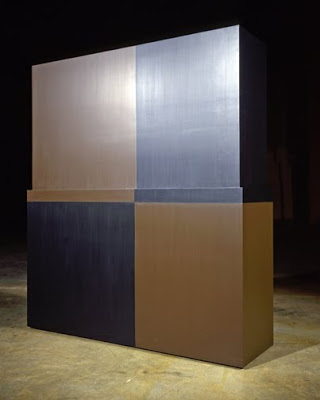Anne Truitt
Art Vent Letting the Fresh Air In
This isn’t De Chirico, but Old San Juan, Puerto Rico, another culture where art isn’t a separate intellectual activity for the privileged, but is as pervasive and natural as the sun.
 Then Stanford, which has to be the most beautiful university campus in the world. Yale and Harvard should weep. This is Palm Drive, three blocks of majestic trees leading up to the campus. One of the students told me that a replacement tree arrived like an enormous rocket on a flatbed truck and sat for awhile on its side near the studios. Cost (I was told): $80,000.
Then Stanford, which has to be the most beautiful university campus in the world. Yale and Harvard should weep. This is Palm Drive, three blocks of majestic trees leading up to the campus. One of the students told me that a replacement tree arrived like an enormous rocket on a flatbed truck and sat for awhile on its side near the studios. Cost (I was told): $80,000.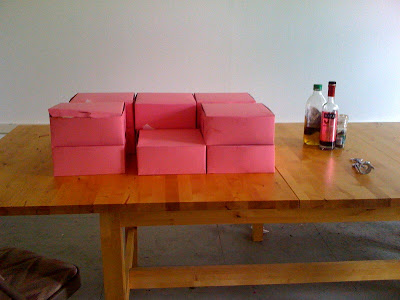 And palm fronds on the ground around the studios:
And palm fronds on the ground around the studios: Finally, the weekend before last I flew back to JFK late Friday night and early Saturday made it up to Central Park West for an all-day
Finally, the weekend before last I flew back to JFK late Friday night and early Saturday made it up to Central Park West for an all-day  This last weekend was the Anne Truitt opening at Matthew Marks, the guests intermingling with the sculptures:
This last weekend was the Anne Truitt opening at Matthew Marks, the guests intermingling with the sculptures: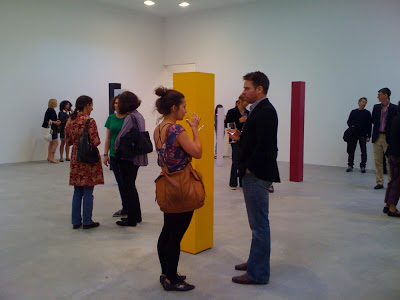 For the next few weeks I intend to hole up in the Berkshires, finish off one essay, write another, and get up to speed in the studio. Oh, and work in the garden and finish the taxes I got an extension for. It never ends.
For the next few weeks I intend to hole up in the Berkshires, finish off one essay, write another, and get up to speed in the studio. Oh, and work in the garden and finish the taxes I got an extension for. It never ends.

I’m about to descend into Armory madness. For reading material I hope you’ll turn to my article on Anne Truitt in the March Art in America.
 Anne Truit, First, 1961. Latex on wood, 44 1/4 x 17 3/4 x 7 in. The Baltimore Museum of Art: Gift of the artist, Washington, DC. Artwork © Estate of Anne Truitt/The Bridgeman Art Library
Anne Truit, First, 1961. Latex on wood, 44 1/4 x 17 3/4 x 7 in. The Baltimore Museum of Art: Gift of the artist, Washington, DC. Artwork © Estate of Anne Truitt/The Bridgeman Art LibraryNot wanting to anchor the work in a linear narrative, or imply that her sculpture in any way ‘illustrated’ a particular event, Truitt herself was reticent to make fully explicit the connections she nevertheless acknowledged between her life and art. Instead she emphasized the importance of the transformation from the specific to the universal in her process.
After stating clearly what the artist would not have wanted, Hileman turns around to do exactly that:
The elucidation of some of the events, places, people, literary references, and philosophies that appear to constitute fragments of the iconography Truitt perceived behind her ultimately irreducible works, however, provides another lens through which to consider Truitt’s unique and highly expressive deployment of the objective language of color and geometry.
Hileman then, throughout the essay, continues to interpret Truitt's work through biography as in:
Inanimate sculptures that do not include a video monitor and on which nothing is written cannot “convey” or “appear to convey” anything, and any “psychological dimension” that can be associated with an art work is elicited by the configuration of the work itself, not by specific pre-knowledge of the artist’s history.
Granted Truitt, having published her memoirs in three volumes, invites this sort of exercise more than most, however the dependence of critics and curators on information that is not intrinsic to the work is epidemic—and, because the backstory is so often used to justify or rationalize what's on view, I will even go so far as to say that it’s responsible in large part for the ridiculous amount of bad art we see out there (an artist friend wanted to blame it on the artists, but they’re not the ones making the selections, and further, this kind of thing only encourages them to think that’s what art is).
Interpreters of art seem unable to deal with the object itself and instead rely on externals, often having to do with the artist’s “intention” or political bent or, when dealing with artists like Luc Tuymans or Josh Smith, how their work represents some kind of reaction to the history of painting. But it’s really simple. The work is the work, no matter who did it, when s/he did it, or why s/he did it. Biographical information, such as the fact that Richard Serra had day jobs in steel mills is worth noting if trying to determine how he arrived at his format, but the work itself, that big thing made of metal, is something else entirely. What does it convey or express? Nothing. What are its “psychological dimensions?” None.
While in Washington on Friday to see the exhibition and catch James Meyer’s excellent gallery talk (Meyer being the perfect example of an art historian who knows what’s important and what isn’t), I also had lunch with Tyler Green of Modern Art Notes, who said he thought that with the advent of photography, writers about art were not so inclined to engage in elaborate description.
If so, this could explain a lot, because for me, it’s through being forced to describe something that I learn what it is and what I really think about it. In fact this is why I write about art at all, because I wouldn’t engage in such a detailed exercise on my own. It’s how I learn, and it’s how I teach students to write about art. In fact I think everyone studying any aspect of the arts should be required to take art writing, not so they can better write their theses or that noxious item we call the artist’s statement, but because through writing description you learn to observe what’s outside—and inside—you. And no matter what the endeavor—be it art, bricklaying, dentistry or cooking—observation is everything.
 Anne Truitt, Pith, 1969
Anne Truitt, Pith, 1969This season, however, got an early start with Glenn Beck’s debut as an art critic, which would be hilarious if there weren’t those out there who take him seriously. But why do we need Glenn Beck when we have our own Charlie Finch, who approaches his subjects with similar breathy astonishment and twisted logic? Consider his passive-aggressive Artnet piece (entitled “Mother-in-law”) on the late Anne Truitt’s upcoming survey at the Hirshhorn, where he mixes grudging admiration for her work (“The Hirshhorn retrospective should vault her into a special pantheon of her own, one which she occupied in privacy during her own life and in public now that her work belongs to the world”), with obvious glee at finally having an opportunity to get back at the bitch.
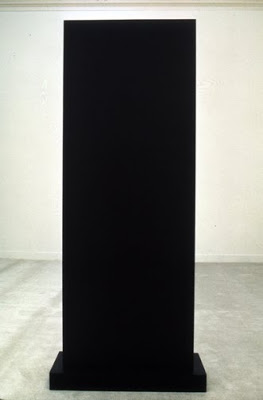 Anne Truitt, Hardcastle, 1962
Anne Truitt, Hardcastle, 1962Not to speak of being sexist while pretending to be critical of those who were. But I’ll get back to that in a moment.
Finch starts out by saying, “She was the driest, most detached person I had yet encountered, so removed that she toasted us young newlyweds at our reception by remarking that ‘it is like watching them go down Niagara Falls in a barrel.’" Hmmm. Far from being detached and removed, it sounds as if Truitt was nothing but present and prescient, feeling as any parent might on the occasion of her daughter being married to this guy.
In true Glenn Beck-like fashion, the revengeful son-in-law randomly weaves together biographical non sequiturs to make Truitt sound like a nut job: “She was obsessed with Alexander the Great, kept a picture of her Indian guru, whom she had never met, on her kitchen wall, and, at one point, conspired with other powerful Washington wives to drug their husbands’ cocktails with LSD in order to end the Vietnam War, though this plot was probably never realized.” Oooh! A picture of a guru on her wall! That she’d never met! As for the LSD plot, I’d like to see it properly footnoted. And God help me if some future biographer ever finds out how many books I’ve read on Elizabeth I.
Or how, in the studio, “she was painstaking to a fault” (to a fault?) and that one sculpture “marks the beginning of a self-enforced calm” as if she was barely able to keep the lid on.
Finch’s sexism can be found in the order of things: “In the politics of art, she had helped Morris Louis' widow unroll his canvases, enjoyed a collaborative relationship with Kenneth Noland and was championed as an original by Clement Greenberg.” How differently these examples would read in reverse.
 Anne Truitt in her Washington studio, 1962 (all images from annetruitt.org)
Anne Truitt in her Washington studio, 1962 (all images from annetruitt.org)  Anne Truitt, Valley Forge, 1962
Anne Truitt, Valley Forge, 1962As a child I had to fight for abstraction (“It’s a besign!” I’d insist to the teachers who challenged me). But everything’s relative. The other night my friend, Alexandra Truitt, daughter of the late sculptor, Anne Truitt, told me that, filled as the family home was with work by Frankenthaler, Morris Louis and Noland, she was nine before she realized paintings could also be pictures. Of things.
She described living in Japan (where her father was bureau chief for Newsweek) and excitedly bringing a book of paintings by Keane, which she’d found at school, to her horrified parents at the dining table:
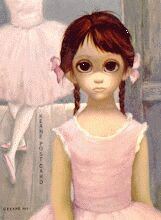 This was her next crush:
This was her next crush:
Sakamoto Kyu
I guess there’s no such thing as a “normal” childhood.
